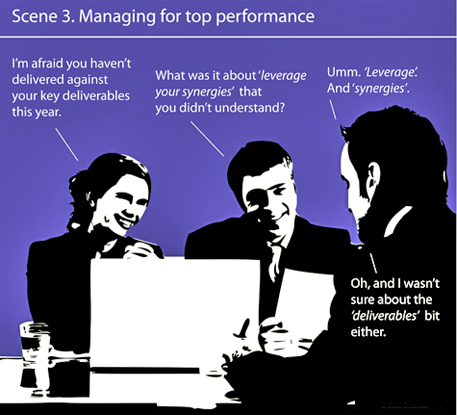| |
|
I found some new words the other day and I’ve been itching to use them. They were in an article referring to phrases and sayings of the moment that are on the point of entering our language through common usage. Not yet in our dictionaries, they’re hovering expectantly as de rigueur fashionable phraseology in the halls and corridors of today’s management élites.
They include the quaint but unlovely concept of ‘circling the drain’, from medical terminology that describes people, as the newspaper put it, in ‘a near death situation’. Then there’s ‘blamestorming’, a potentially useful device where instead of dredging up daft ideas your group searches for people and systems to blame for everything that’s going wrong – a new take on blue-sky thinking, I suppose. And when things do go wrong it pays to be able to identify your organisation’s ‘stress puppy’. Apparently most outfits have one (if so, he or she should be drowned on discovery).
Employees don’t move jobs these days, they ‘transition’. They’re no longer likely to leave, but are labelled as ‘a flight risk’. No more are they considered shortsighted or lazy, now they are ‘incapable of helicopter thinking’ and ‘fail to sprinkle granularity’ in their reports.
Such ego-inflating jargon is also the new language of government and the media. Journalists are no longer ‘with our boys at the front’ in Iraq, they are ‘embedded’ with frontline troops. (I would have thought this so ‘last season’, but what do I know?).
As proof that our world has now become linguistically challenged, I recently heard that famous British TV rogue Arthur Daly (from the Minder series) described not as a used-car salesman (the job in which his character rejoices), but as a pre-owned vehicle reallocation consultant.
Imagine that. No more would Sam ‘Mayday’ Malone from Cheers be described as a mere bartender. These days he’d be a recreational beverage dispensation operative. And dear Frazier Crane would no longer be your favourite phone-in therapist, now he’d be your personal on-line trans-airwave psycho-advice counsellor.
A weird kind of circumlocution seems to have seeped into our business and even our private lives, one that cloaks most of our meanings in fog. Nowhere is this more evident than in the routine utterances of the voluntary sector (ie, us).
We fundraisers love our jargon and rarely if ever seem to challenge it. At the end of the day, if we think outside the box, we all want our communications strategies to exemplify state-of-the-art clarity, to consistently yet flexibly move our constituents in a willing mode towards underwriting our fundraising efforts with their committed major gifts.
Or put more plainly, we aspire to move people so they’ll give us their money. It’s just that the language we use so often gets in the way, thanks to this seemingly universal tendency to forgo clear expression and wrap all our utterances in verbal sludge. Everywhere you look these days the ubiquitous language of ‘third-sector-speak’ rises unbidden, suffocating ideas and vanquishing meaning from almost anything you choose to read. Frankly, it’s getting up my nose.
As other professions, nonprofits have their own sub-languages which they too often inflict upon their donors or customers. Seeking perhaps to impress but more likely to deceive they regularly use improper words improperly, such as ‘disincentivisation’ and ‘uniquenesses’ or barely comprehensible words that describe barely comprehensible processes, such as ‘scalable’, ‘proactive’ and ‘scoping’. They will use a long word in favor of more easily available and understood short ones – eg ‘functionality’, meaning functions, ‘learnings’, meaning lessons, ‘to dialog’, for to talk, ‘operationalize’, meaning do, and so on. Or they’ll use a vague phrase where one precise word will serve better. For example ‘at the end of the day…’ when they mean ‘finally’. They refer to ‘seamless end-to-end solutions’, which George Orwell would have referred to as ‘gumming together long strips of words’ (I love the JargonWatch website’s definition of that ubiquitous term ‘solution’. They say ‘Companies no longer sell products or services; they sell ‘solutions’, which are products or services, but more expensive’). Nonprofits also often employ whole clutches of words to bestow self-importance, such as ‘donor disengagement’ which sounds much more grand than what they really mean, withdrawals or cancellations. And with abandon whole segments of former donors will be condemned as ‘lapsed’ (these misguided people sound almost biblical and faintly improper, like fallen women) or stigmatised as something worse, perhaps ‘the sediment’ or ‘the residue’.
What’s the point of understanding them,
if they can’t understand us?
The first rule of communication is that you must talk to people in their language, not yours. Fundraisers down the pub on a Friday night may jabber in the jargon-laden language of the voluntary sector (not those that I socialise with, but others might) but donors almost certainly don’t. So surely we should guard against it when we write. Such leaden sentences are unlikely to penetrate the consciousnesses of the people we are seeking to reach.
How can I put this simply then? Wrapping up your thoughts in unnecessary, unclear verbiage does not impress, it doesn’t make you look smart, it simply shows that you are a dork. If you want to succeed as a communicator, keep your meanings clear. Try out everything you write first on a 12 year old.
But the problem with most nonprofit communications, it has to be said, is not so much that they overflow with jargon but that they are so dull. This is a shocking admission given the abundance of colorful, dramatic, evocative human interest material with which most nonprofits are blessed. But sadly it’s true. Fundraisers are prolific producers of printed and electronic communications but the bulk of it is tedious, vacuous, or fit only for the trashcan, or all three. Along with excessive use of jargon, organisation-speak and too-long words, common weaknesses in our communications include too many words, limited skills in designing for readability and overemphasis on what the organisation wants to say, rather than on what the reader wants to read. If you think this a little harsh, send off for the newsletters or annual reports of say 20 other prominent nonprofits, and see if I’m wrong.
The most crucial question of all for fundraisers to answer honestly may well be ‘do your donors really read what you send them?’ Many of us would not be very encouraged by the answer. But we shouldn’t lose heart, for this really is an area where fundraisers can do very much better.
Ideally, you should send only communications that will help ensure your supporters
- Are entirely comfortable with what they receive from you.
- Will grow in their trust and confidence in you and your organisation.
- Will actually look forward to hearing from you.
- Only hear about issues and subjects that truly interest them.
- Give when you ask.
- Feel they are benefiting from the relationship too.
It’s important that fundraisers become more self-critical of what they produce so they stop sending uninteresting, hard to understand and unwelcome communications and only send readable, creative, effective communications. If we wish to avoid donor fatigue we have to send less, but better, to make sure what goes to donors is only good.
Many fundraisers could save the money they currently waste on inappropriate and poorly constructed publications by not sending them, thus avoiding inflicting unhelpful, unwelcome materials on donors and ensuring that when high quality materials arrive they will be wanted and used. They can then reinvest what they’ve saved to produce better communications that will be worth receiving.
Fundraisers should constantly measure donors’ interest in and reactions to what they are sent, and learn from this. We have to ask ourselves – honestly – whether or not our donors actually read what we send them.
Given the urgency of our appeals, fundraisers never have any excuse to be dull, bland or unmoving. We have to always communicate with power and passion remembering we have the best stories in the world to tell and the best reasons for telling them.
© Ken Burnett.
This feature is adapted from an article that first appeared in 2005 in Contributions magazine.
|
|

‘I’ve noticed that almost everything in the business world has to be ‘leveraged.’ If you’re not busy leveraging something, you’re not doing your job. Whenever I talk to my boss, I make sure to use the word ‘leverage’ at least once in every conversation, and it seems to keep me employed.
‘In addition, whenever our department has something new to present, like a new procedure or policy, we say we’re going to ‘roll it out’, as if it were some kind of enormous pie crust. This is an image I like, especially right after lunch.
‘While in the process of rolling out and leveraging, however, it’s important that we have ‘transparency’ – meaning, I guess, that everyone knows what you’re rolling and leveraging. It took me almost three years to learn all this.’
Nancy Crochiere, USA columnist.


Our icons on national television actively promote the trend towards ever more surplus or imprecise verbiage. As the British politician Boris Johnson famously said, ‘I couldn’t fail to disagree with you less’. He meant ‘I agree’. Here are a couple of chunky quotes, one taken from the UK national newspaper The Guardian, the other from a recent issue of a leading fundraising journal. See if you can decode the ideas these writers are seeking to convey and come up with a better way of saying it.
‘A cross-pollination of creative properties in multiple media formats with a vertical market approach allows companies to maximize returns.’
‘Strategies have moved out of the box marked ‘I know we need one of those, but I’m not sure why’, into a box marked ‘Bridging to the outside world and road map for the future’.’
One of the above was awarded this year’s Golden Bull award for incomprehensible gibberish. The other was pulled out from its accompanying article as a bold quote, hopefully by a sub with a sense of humor.


Disagree with me? Or agree? If you’ve anything to add, have your say here. Email your thoughts or comments now to me and providing they’re relevant and appropriate I’ll put them on the site.
Sign up here for more OPINIONS coming soon
If you’d like to be informed in advance of opinion blogs and stories from Ken Burnett, please email here with just ‘add me to your blog list’ or something similar in the header. You can opt out at any time.


The Inch Hotel, Loch Ness, inspirational setting for Clayton Burnett’s transformational events.
 ooooo ooooo
Ken Burnett is a director of Clayton Burnett Limited, The White Lion Press Limited and he’s a former chairman of the board of trustees at the international development charity ActionAid. He’s author of several books including Relationship Fundraising and The Zen of Fundraising and is managing trustee of SOFII, The Showcase of Fundraising Innovation and Inspiration. For more on Ken’s books please click here.
|









